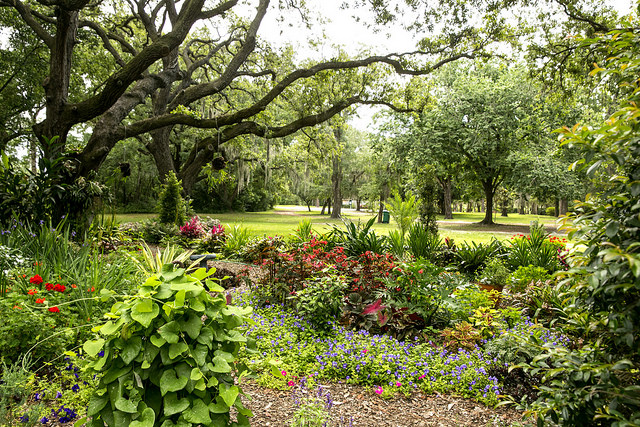This story was published online for IDEAS for US, CLICK HERE TO CHECK IT OUT
Earlier this month, I went on an Eco tour at Mead Gardens located in Winter Park, Florida. Mead Gardens is a botanical garden created in the memory of T.L Mead for his love of botany, butterflies, and trees. Mead was known for his hybridization of different Florida native plants that are popular in many lawns today. Within the botanical garden, one can find themselves one with nature by getting lost in the beauty of the 40 plus acre garden. There are bike trails, butterfly gardens, a green house, an educational center, and gopher tortoise burrows and this is only naming what I was able to see on my tour of the landscape.
The eco-tour was sponsored by I.D.E.A.S. for US, an environmental sustainability and action based non-profit organization in collaboration with Mead Gardens. We were lucky to be accompanied by Chris Castro, founder of I.D.E.A.S., along with John Nico, who works at the gardens as our tour guides. Dr. Joseph Siry, associate professor of Environmental Studies at Rollins College, also spoke throughout the tour.
We started our journey at a clay pit located at the garden. This clay pit along with a nearby body of water was given to the gardens by Orange County at its conception. Formerly a junk yard, the staff is and has been working to clear this area out of both junk and non-native Floridian flora.
One example of an invasive species growing there were, air potatoes. A member of the yam family, which form a potato like nub and have tubular roots just like any baking potato you grow in your own garden. The dangers with air potatoes are their ability to grow about eight inches a day via vine that can literally choke out native plants.

Additionally, the water in this area is badly polluted by excess nutrient enrichment, or eutrophication. Residential neighborhoods line the gardens and many of these households are partly responsible for this polluted water. The use of fertilizers, pesticides, oil (for lawnmowers or cars), and soap (from car washing), contribute to this problem when they are washed down the storm drain or leech into the soil. These compounds make their way into our water systems, add excess nutrients such as nitrogen, phosphorous, or magnesium and can slowly create an anoxic (lack of oxygen) environment that kills off plants, animals, and other organisms that were once part of that aquatic ecosystem.
The body of water near the clay pit at Mead, is currently having issues with eutrophic conditions. They are urging local residents to do their part by limiting the use/being mindful of these harmful chemicals they are using. They are having minor success with local communities jumping on board but still face the opposition from more well off neighborhoods who feel entitled to do as these please with little regard as to how it effects surrounding ecosystems. My message to those homeowners is simple. Do as you may, you have free will as a human being, but you are hurting our water quality and our soil quality. You are destroying habitat for other creatures on this Earth. Wouldn’t you think the most intelligent species on Earth is smarter than that? Think about that before you go to bed at night. Think about the world your children will live in. There are consequences to every action that you take.
On a lighter note, the rest of the tour was extremely beautiful and just as educational. A whole section of the garden was planted by the Florida Native Plant Society and features, you guessed it, only native Floridian flora. This area is flooded by butterfly wings, crickets and even a turtle nest. Each plant had a description of what it was, it’s scientific name and what type of wildlife it attracted. Located close by was an amphitheater that had been recently built that was surrounded by a body of water. John Nico, our tour guide, let us know that the area had also previously been a junk yard. The amphitheater was built to prevent any pollutants from spreading further to other areas. It serves a barrier to contain this man made mess. Next on our tour was the butterfly garden and a pond named after a volunteer called, Jane’s Pond. Jane is an elderly women who is dedicated to the upkeep and development of the garden and even stopped by our tour group to say hello.
Our last stop was an area that was surrounded by flags and a post with a sign. The sign described the gopher tortoise and the burrows that this creature creates. Gopher Tortoises are the keystone species of their ecosystem, meaning that without these creatures the entire ecosystem would fall apart. The burrows these creature make are essential to over 300 different organisms that live within these ecosystems. If these tortoises were somehow wiped out or displaced (due to habitat loss or development), the entire ecosystem would be at risk and eventually fall apart. It’s amazing that by simply removing a keystone species that you destroy an entire ecosystem. Incredible how every microorganism, plant, animal, insect etc. has a role, whether that role is minute or vital, keeps that ecosystem in balance and effortlessly in motion.

My experience at Mead Gardens was a positive one and I encourage anyone in the Orlando area to check it out. You will feel a deep connection with nature and rediscover the beauty that is right outside our homes. Always remember that you are ONE with nature, there is no separation between man and the environment. We depend on our environment on a daily basis and will continue to do so for the rest of our lives.
-Kaila Varano
IDEAS For UCF

